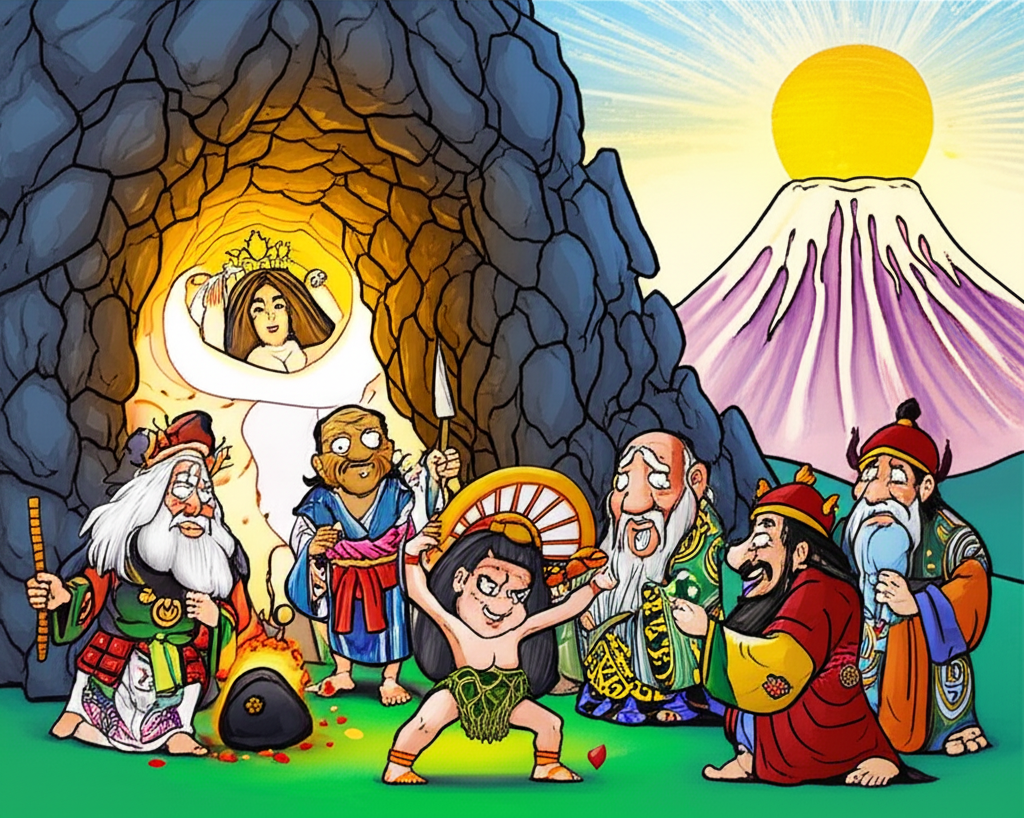
In the verdant, mist-shrouded islands of Japan, where ancient traditions intertwine with the dramatic tapestry of nature, stories have been whispered for centuries, shaping understanding and awe. Among these tales, one speaks of the very genesis of a mountain that has become an enduring symbol of the nation: Mount Fuji. This narrative, rooted in the Shinto faith, is not a historical account nor a divine decree, but rather a vibrant piece of folklore, a testament to the imaginative power of ancient peoples seeking to explain the awe-inspiring world around them. It is a story about Amaterasu, the radiant goddess of the sun, and her profound connection to the land, a connection that, according to this legend, gave birth to the majestic peak.
The cultural soil from which this myth sprung was a Japan far removed from the bustling metropolises of today. Imagine an era where life was intimately tied to the cycles of nature, where the sun’s warmth meant survival, and the earth’s bounty was a constant source of wonder and sometimes, fear. In these ancient times, the world was viewed as a realm teeming with spirits, or kami, residing in all aspects of the natural world – from the rustling leaves of ancient trees to the crashing waves of the ocean, and, of course, the towering mountains. These kami were not necessarily benevolent or malevolent in a human sense, but rather forces that influenced human destiny. Natural phenomena were often interpreted through the lens of divine actions, and the creation of monumental features like mountains was attributed to the powerful beings who governed the cosmos. This was a worldview that fostered a deep reverence for the natural world, seeing it as a living, breathing entity imbued with spiritual significance.
At the heart of this legend stands Amaterasu Omikami, the revered goddess of the sun, a central figure in the Shinto pantheon. She is depicted not as a mere celestial body, but as a powerful, luminous deity, the ultimate source of light and life. Her radiance is said to banish darkness and bring warmth and prosperity to the land. Symbolically, Amaterasu represents illumination, order, and the benevolent power of the heavens. Her association with the sun signifies purity, truth, and the cyclical renewal of life. She is often portrayed with regal bearing, a figure of immense authority and grace, whose very presence dictates the rhythm of the day. In this myth, her divine essence and her connection to the earth are central to the dramatic transformation that births Mount Fuji.
The narrative begins with Amaterasu, residing in her celestial realm, gazing down upon the earthly domain. She was a goddess of immense power, yet she also possessed a deep affection for the mortal world, a world she illuminated each day. It is said that during one of her contemplative moments, her gaze fell upon a particular region of Japan, a place of undulating hills and fertile plains. She found herself drawn to its beauty, its potential, but also, perhaps, to a certain stillness that awaited its grandest expression.
In her divine wisdom, Amaterasu decided to imbue this land with a portion of her own radiant energy, a gift that would forever mark it as a place of special significance. She conceived of a magnificent mountain, a peak that would reach towards the heavens, a visible testament to her power and a sanctuary for the spirits of the land. To achieve this, she sought a specific location, a place where the earth’s energy was particularly receptive.
According to the legend, Amaterasu descended from her celestial abode, not in a blinding flash, but in a gentle, radiant descent, like the first rays of dawn breaking over the horizon. She entered a deep, hidden cave, a place where the earth’s primal forces were said to converge. This was Amaterasu’s Cave, a mythical grotto that pulsed with the very essence of creation. Within this sacred space, the Sun Goddess began to channel her immense, life-giving power into the very bedrock of the earth.
It is said that the process was not instantaneous, but a gradual unfolding, a magnificent act of divine shaping. As Amaterasu’s radiant energy flowed, the earth beneath her began to stir and swell. The land groaned and shifted, not in pain, but in a powerful, transformative embrace. The cave, filled with the goddess’s luminous presence, became the womb of a new geological wonder. The pressure and heat generated by her divine power caused the earth to rise, to push upwards, creating a colossal mound that grew and grew, reaching towards the sky.
The legend describes how, over an immeasurable span of time, the earth continued to ascend, shaped by the unseen, yet potent, force of the Sun Goddess. The cave, once a hidden sanctuary, became the very foundation from which this colossal peak emerged. As the mountain grew, its summit, kissed by the heavens, became a place of unparalleled beauty, often veiled in ethereal clouds, a silent monument to Amaterasu’s creative act. The snow-capped peak, reflecting the sunlight, was seen as a direct link to the goddess herself, a perpetual reminder of her celestial presence. Thus, the myth tells us, Mount Fuji was born, not from volcanic eruption or tectonic plate movement as modern science explains, but from the divine touch of the Sun Goddess, a gift of radiant energy captured within a sacred cave.
For the ancient people who shared this story, the myth of Amaterasu’s Cave likely represented several profound concepts. The mountain itself, as a towering natural landmark, would have evoked a sense of awe and mystery. Its formation attributed to a benevolent deity like Amaterasu would have fostered a deep respect for the divine forces believed to govern the natural world. The mountain could have symbolized stability and permanence, a constant presence in a world of change. The connection to the sun goddess would have imbued it with purity and sacredness, making it a place of spiritual significance, a point of communion between the earthly and the celestial. Furthermore, the legend could have served as a way to understand the immense power of nature, attributing its grandest creations to forces far beyond human comprehension. It provided a narrative framework for the inexplicable, grounding the awe-inspiring in a story of divine action.
In contemporary times, the myth of Amaterasu and the origins of Mount Fuji continues to resonate, albeit in different forms. While no longer held as a literal truth, it remains a significant element of Japanese cultural heritage. It is explored in literature, where authors draw upon its rich imagery and symbolism to weave tales of ancient Japan and its spiritual landscape. In visual arts, Mount Fuji itself is a recurring motif, its majestic form often infused with the mythical narrative of its divine creation. Popular culture, including manga, anime, and video games, frequently incorporates elements of Japanese mythology, and Amaterasu, along with the iconic silhouette of Mount Fuji, often makes appearances, reinterpreting these ancient stories for new audiences. In academic circles, these myths are studied for their insights into the worldview, beliefs, and social structures of ancient Japanese societies.
It is important to reiterate that this tale of Amaterasu’s Cave and the birth of Mount Fuji is a traditional story, a product of human imagination and the desire to understand the world through narrative. As Muslims, we recognize that the ultimate Creator and Sustainer of the universe is Allah alone, in accordance with Islamic teachings. This legend, therefore, is understood and appreciated purely as a cultural artifact, a beautiful example of human creativity and the enduring power of storytelling. It offers a window into the past, allowing us to connect with the cultural heritage of a people and to marvel at the way ancient societies interpreted the world around them. The enduring appeal of such myths lies not in their literal truth, but in their ability to spark imagination, to foster a sense of wonder, and to preserve the rich tapestry of human cultural expression across generations.





